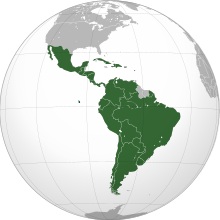 | |
| Area | 20,111,457 km2 (7,765,077 sq mi)[1] |
|---|---|
| Population | 656,098,097 (2021 est.)[2][3][a] |
| Population density | 31/km2 (80/sq mi) |
| Ethnic groups |
|
| Demonym | Latin American |
| Countries | 20[b] |
| Dependencies | 1 |
| Languages | Spanish, Portuguese, French, English, Dutch, Papiamento |
| Time zones | UTC−02:00 to UTC−08:00 |
| Largest cities | Largest urban areas: 1. São Paulo 2. Mexico City 3. Buenos Aires 4. Rio de Janeiro 5. Bogotá 6. Lima 7. Santiago 8. Guadalajara 9. Monterrey 10. Brasília |
| UN M49 code | 419 – Latin America and the Caribbean019 – Americas001 – World |
Latin America often refers to the regions in the Americas in which Romance languages are the main languages. It is "commonly used to describe South America (with the exception of Suriname, Guyana and the Falkland islands), plus Central America, Mexico, and most of the islands of the Caribbean".[4] In a narrow sense, it refers to Spanish America, and often it may[5][6] also include Brazil (Portuguese America).[7] The term "Latin America" may be used more broadly than Hispanic America, which specifically refers to Spanish-speaking countries; and more narrowly than categories such as Ibero-America, a term that refers to both Spanish and Portuguese-speaking countries from the Americas, and sometimes from Europe. It could also theoretically encompass Quebec or Louisiana where French is still spoken and are historical remnants of the French Empire in that region of the globe.
The term Latin America was first used in Paris at a conference in 1856 called "Initiative of America: Idea for a Federal Congress of the Republics" (Iniciativa de la América. Idea de un Congreso Federal de las Repúblicas),[8] by the Chilean politician Francisco Bilbao. The term was further popularized by French emperor Napoleon III's government of political strongman that in the 1860s as Latin America to justify France's military involvement in the Second Mexican Empire and to include French-speaking territories in the Americas, such as French Canada, Haiti, French Louisiana, French Guiana, Martinique, Guadeloupe and the French Antillean Creole Caribbean islands Saint Lucia, and Dominica, in the larger group of countries where Spanish and Portuguese languages prevailed.[9]
- ^ "World Development Indicators: Rural environment and land use". World Development Indicators, The World Bank. World Bank. Archived from the original on June 17, 2016. Retrieved September 12, 2013.
- ^ "World Population Prospects 2022". United Nations Department of Economic and Social Affairs, Population Division. Retrieved July 17, 2022.
- ^ "World Population Prospects 2022: Demographic indicators by region, subregion and country, annually for 1950-2100" (XSLX) ("Total Population, as of 1 July (thousands)"). United Nations Department of Economic and Social Affairs, Population Division. Retrieved July 17, 2022.
- ^ Dressing, David. "Latin America". Encyclopedia of Latin American History and Culture. v. 5, 390
- ^ Bethell, Leslie (August 1, 2010). "Brazil and 'Latin America'". Journal of Latin American Studies. 42 (3): 457–485. doi:10.1017/S0022216X1000088X. ISSN 1469-767X.
- ^ Gistory (September 17, 2015). "Is Brazil Part of Latin America? It's Not an Easy Question". Medium. Retrieved July 17, 2024.
- ^ "Latin America" definition Archived September 22, 2022, at the Wayback Machine. Encyclopedia Britannica, accessed 20 May 2022.
- ^ Bilbao, Francisco (June 22, 1856). "Iniciativa de la América. Idea de un Congreso Federal de las Repúblicas" (in Spanish). París. Archived from the original on September 17, 2017. Retrieved July 16, 2017 – via Proyecto Filosofía en español.
- ^ Britton, John A. (2013). Cables, Crises, and the Press: The Geopolitics of the New Information System in the Americas, 1866–1903. UNM Press. pp. 16–18. ISBN 9780826353986.
Cite error: There are <ref group=lower-alpha> tags or {{efn}} templates on this page, but the references will not show without a {{reflist|group=lower-alpha}} template or {{notelist}} template (see the help page).